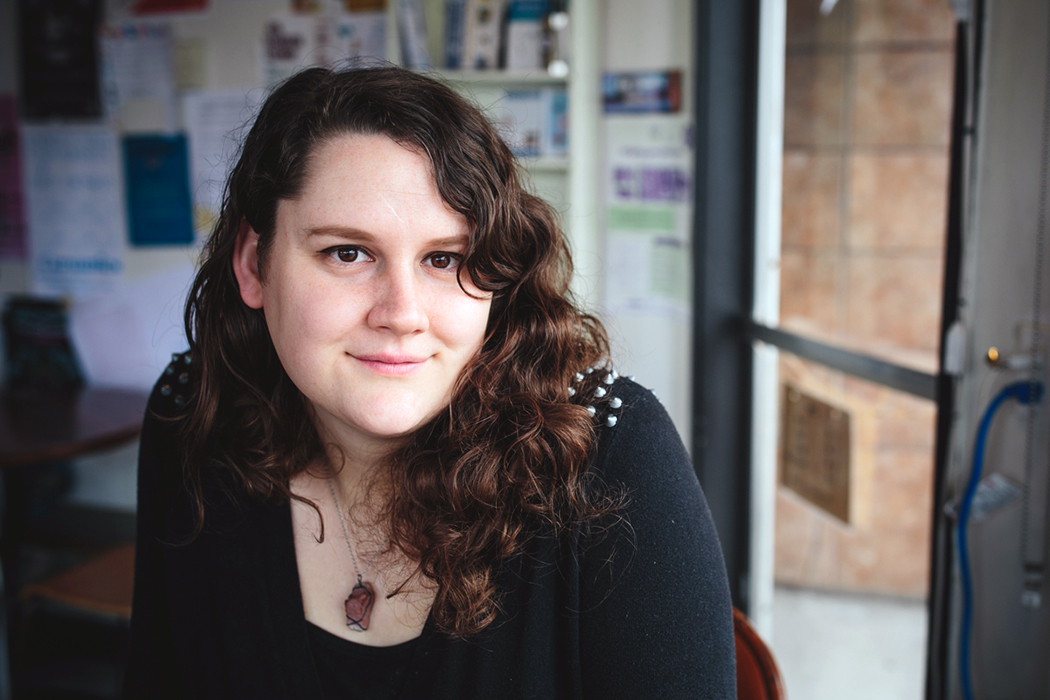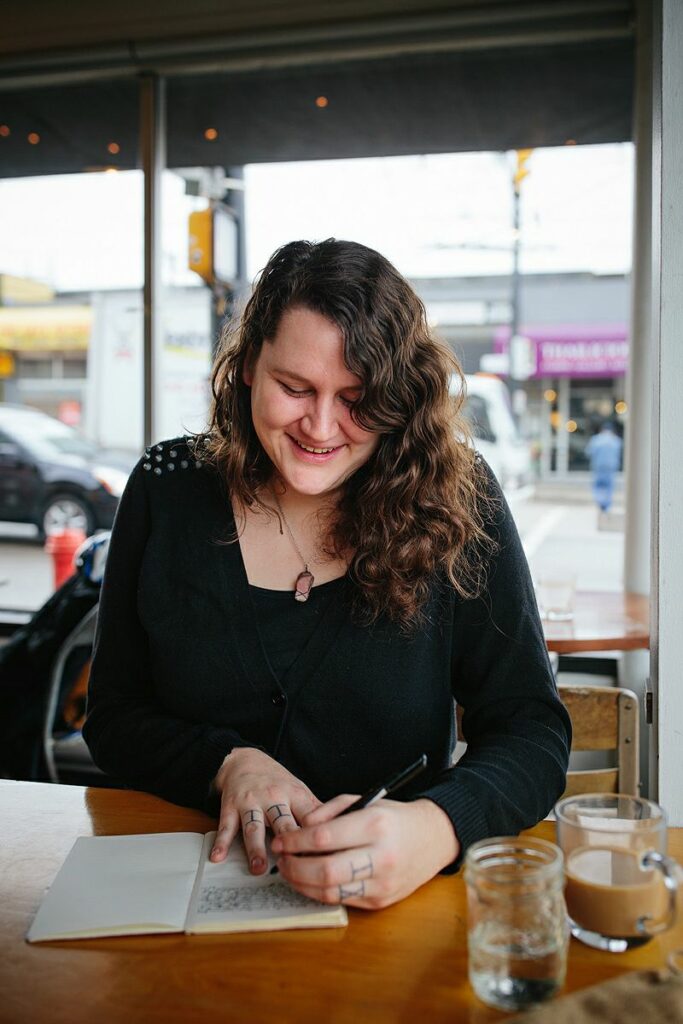Avery Alder on queer roolipelisuunnittelija Sinixt-territoriosta Brittiläisen Kolumbian maaseudulta. Hän on julkaissut pelejä itsenäisesti kuudentoista vuoden ajan. Averyn töihin lukeutuvat Monsterhearts, The Quiet Year, Dream Askew, Ribbon Drive sekä useita pienempiä projekteja. Averyn pelit, sijoittuvat ne sitten luhistuvan sivilisaation keskelle tai arkiseen elämään, käsittelevät sitä, miten identiteettimme, ihmissuhteemme ja yhteisömme muuttavat toisiaan.
Avery on myös työpajasuunnittelija, fasilitaattori ja pelisuunnittelukonsultti. Hän on tehnyt yhteistyötä Tatamagouche Centre -oppilaitoksen kanssa vuodesta 2017 järjestämällä pelituunnitteluretriittejä kuten Designing Games That Matter. Kesällä 2021 Emily Carr University of Art + Design kutsui hänet opettamaan Awakening Transformation Through Roleplaying Game Design -kurssia. Aiemmin tänä vuonna hän kuratoi ja fasilitoi pelisuunnittelutyöpajojen sarjan nimeltä Four Encounters.
Tämä on Averyn ensimmäinen kerta Ropeconissa ja Suomessa.
Kysyimme kunniavieraalta muutaman kysymyksen pelisuunnittelusta ja pelialalla työskentelystä.
Introduce yourself briefly – who are you, and what do you do?
My name is Avery Alder. I’ve been designing and self-publishing tabletop roleplaying games for the past sixteen years. My games tend to explore really personal and human themes, like how our identities change, how our relationships collapse, and how our communities survive. Queerness and societal collapse are topics that reappear and get reconfigured across a lot of my work – probably because they’re the topics I keep coming back to and try to understand better.
I live in Winlaw, a small rural community in the Sinixt territory of Canada. I’m a mother of two, I think season one of The OA is the best television ever written, and I play Golgari. I work from home, both on my own tabletop roleplaying games under the label of Buried Without Ceremony and as a Senior Narrative Systems Designer for Possibility Space, a new video game studio.
How has it been like to build a career in roleplaying games as a queer woman? Have you met resistance due to your gender or queerness?
Roleplaying games have always been an important avenue for me to explore gender and queerness. It’s through creating these imaginary worlds that I’ve been able to better understand how I fit within the real one. I’ve had the great fortune to find a really great community through the roleplaying hobby. I started my design career before I came out, and rather than resistance, what I’ve experienced is a shifting audience for my work, and a shifting understanding of the significance of the games I make. And since I’ve been lucky enough to dodge a lot of that resistance, I’ve seen it as a duty to try and support other queer designers looking to get their work out there in the world.
Who is your biggest inspiration when it comes to designing roleplaying games? Does their influence show in your work?
One of the answers that springs to mind immediately is Vincent Baker and Meguey Baker. Both of them have made contributions to game design theory that are accessible and impactful, and that have shaped how I think about game design. That includes Vincent’s thoughts on fictional positioning and how social consensus shapes play, and Meguey’s framing of I Will Not Abandon You play. Apocalypse World has had a huge influence on my work. It helped me better understand fiction first design, and its mechanics and play style are foundational to everything I did in both Monsterhearts and Dream Askew.
But a lot of other names come to mind as well. Alex Roberts is an exemplar in design elegance, always supporting her players without ever introducing a superfluous word or mechanic. Sharang Biswas has expanded my mind by always pushing the envelope of what game mechanics can be or do, invoking the senses and the body in new ways. Everyone at Possum Creek Games is showing me how vibrant creative collaborations can emerge from deep friendships, and how good communication and mutual support can make sure that those friendships remain a foundation for future design work.
Ropecon’s theme this year is “friendship”. What does friendship mean to you? Does it show in your games?
I think friendship is a really malleable container. It means different things to different people, and at different times. That’s a big part of its power: whether you need someone to laugh with and feel easy around with, or whether you need an emotional pillar to support you through painful times, that’s a friend.
My games have often explored what happens when relationships are strained, whether it’s individual relationships or broader community networks. Part of my motivation in exploring those moments is about finding the drama and the pathos, but the other part is finding the rays of hope and strength that still shine through. Telling stories about relationships that are going through hard times allows you to discover just how powerful a force like friendship can be.
Community plays an important role in many of your games. Why is this? What other themes are of particular importance to you in your work?
Community is a big concept that I’ve spent a lot of my life trying to grapple with. I think it’s a core part of how we find meaning and belonging in the world. At the same time, I’ve seen people harmed by what they’ve been told is ”for the good of the community”. A community can support and uplift someone, but it can also trap and control them. For all these reasons, I think community is a really important concept to interrogate and try to understand more deeply.
Right now, we live in a world structured around capitalism. That’s a really individualistic and transactional world. I also don’t believe it’s a world that is sustainable, or one that will survive my lifetime. If and when those individualistic and transactional systems start to collapse, it will be our ability to create and sustain healthy and self-aware communities that will allow us to survive and thrive. Games that explore imaginary communities help us prepare for that work to come.
When you start working on a new game, what comes first? The theme, the setting, the mechanics, or something else?
Any of them can come first, in my experience. There are dozens of themes, settings, and mechanics bouncing around in my head, begging to be designed into games. But in isolation, none of those elements alone is enough to create around. It’s just a novel and a fanciful idea. It’s only when many of those elements become wed to one another, colliding together to produce a third entity greater than the sum of its parts, that the design process can begin fruitfully.
It’s how those elements feed into one another that makes game design interesting.
Are you working on anything right now? Can you tell us about your future work?
I have a few design projects that are currently in limbo. Going For Broke is a short sitcom game about a collective house that’s always struggling to pay rent. Monsterhearts: Can’t Lose is a supplement for Monsterhearts focused on the high-stakes world of high school sports. Teenage Nightmare is a diceless, MCless re-imagining of Monsterhearts based on the Belonging Outside Belonging system. Right now, the logistics of regularly playtesting them remotely has been a hurdle in moving towards publication.
My other future work lies with Possibility Space, where I’m working as a Senior Narrative Systems Designer. It’s a wonderful studio, and I’m really excited about the project we’re working on right now!
What are you looking forward to in Ropecon 2022?
I’m excited to learn more about the Nordic roleplaying community, to get to play new games and have my brain shaken up by interesting talks! I visited Malmö in 2014 as part of Nörd på Pride, and Fastaval in 2018 as a guest of honor, but since then have had little opportunity to connect with this community. The design work and thought coming out of this area of the world is some of the richest and most challenging I’ve ever encountered, and I’m excited to visit Helsinki to experience more of it.

